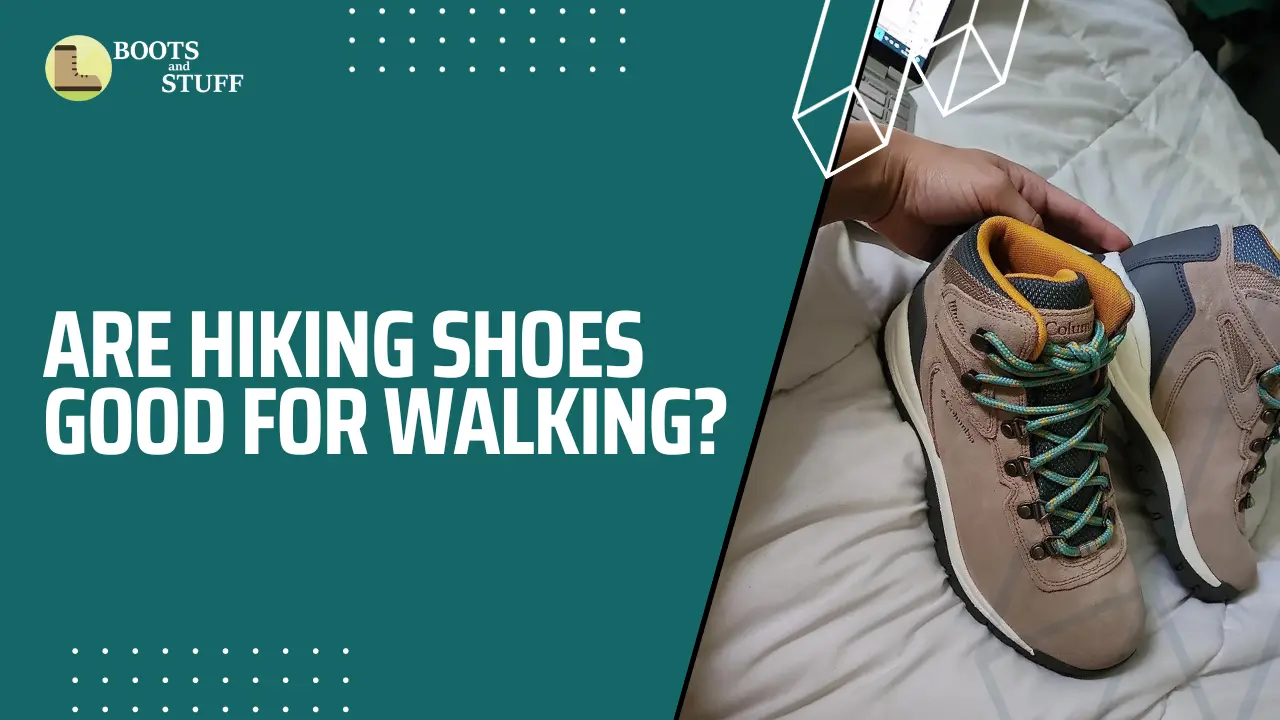Nothing lasts forever, and we are talking about hiking boots here. You may hike on rocky foothills, slimy riverbeds, and muddy fields. All the unforgiving terrains are waiting for your adventure, and your favorite pair is saving your feet through thousands of miles.
I saw hikers often ask about the lifespan of their hiking footwear. How long do hiking boots last? How many years or miles?
For a successful trekking experience, one must have good-quality hiking footwear and other equipment. Generally speaking, hiking boots are not cheap. Good-quality boots are pricey, but as a hiker, you need to know their actual lifespan. It is very difficult to know how many years or months are left to serve you.
The lifespan of a pair of hiking boots depends on some factors that determine their durability or lifespan, like the quality and types of your hiking boots, your storage, maintenance, the construction of the footwear, terrain and weight, and most importantly, the weather condition when you choose to typically make your adventure.
In this comprehensive blog, I’ll explain everything about the durability of hiking boots according to their quality and give you a step-by-step guide that you can follow to take care of your footwear, which will definitely increase its lifespan.
For more information on the most durable hiking footwear, you can read our ideal hiking boots for Newcomers guide, in which our experts reviewed some of the best-quality boots in 2023 that are available on the market right now.
Contents
- How Many Years Do Hiking Boots Last?
- How Many Miles Do Hiking Boots Last?
- Important Factors Determining the Lifespan of Hiking Boots
- 6 Steps for Increasing the Lifespan of Your Hiking Boots
- Step 1: Store Your Hiking Boots in a Temperature-Controlled Room
- Step 2: Apply Leather and Waterproofing Treatments to Your Shoes
- Step 3: Always Maintain Your Boot’s Cleanliness by Removing Dirt and Debris
- Step 4: Remove The Moisture from Your Boot Insoles Regularly
- Step 5: Replace Your Insoles If They Start to Lose Support
- Step 6: Eliminate Minor Issues
- Frequently Asked Questions:
- Wrap Up
How Many Years Do Hiking Boots Last?
Hiking boots can last for over 10 years! I’m not joking! After this period, you can replace your hiking boots and purchase a new pair, but those boots should be heavyweight. The lifespan of a hiking shoe mostly depends on its type, and there are mainly three types of hiking boots available on the market. They are:
- Heavyweight hiking boots
- Midweight hiking boots
- Lightweight hiking boots
Heavyweight Hiking Boots
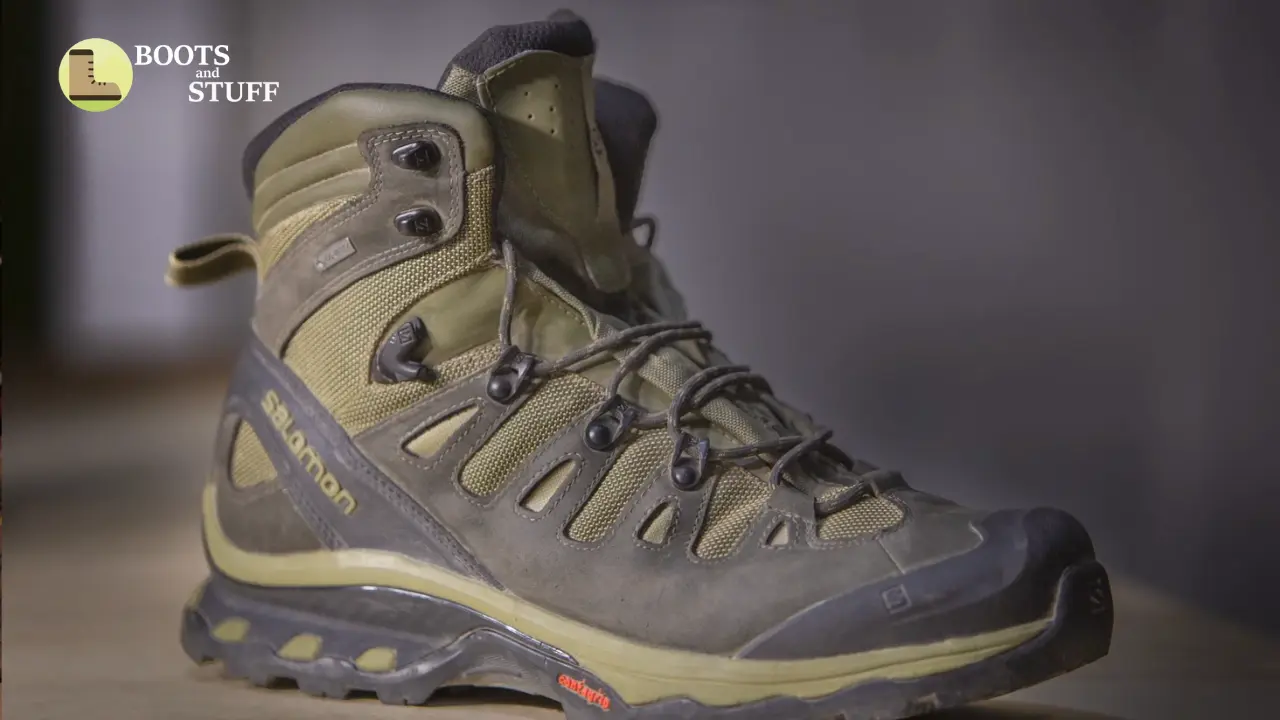
The heavier the hiking boots, the longer they will last, and the heavier hiking boots last for 7 to 10 years, approximately.
Traditional hiking boots tend to be heavier, and they are made for hiking in rugged terrain. If you want to carry heavy loads, then these boots are ideal for you.
But if you find a pair made of full-grain leather and another one made of synthetic fabric, choosing the leather-made boot will be a good decision.
Midsoles made with polyurethane (PU) last longer compared to those made of ethylene-vinyl acetate (EVA). So, when you are purchasing your pair, don’t forget this fact.
Midweight Hiking Boots

Midweight hiking boots last for 5–6 years or less. The uppers are generally made with leather or synthetic fabric of this type. Midweight boots will not provide the support and protection that heavyweights do, but they are still a good option rather than a cheap one.
Midweight hiking boots have a shorter breaking period. You can easily break in them if you follow our how to break in hiking boots guide. This helpful guide will provide you with some important information that you need to know before breaking in your hiking boots without destroying them with silly mistakes. So, don’t forget to check.
Midweight boots are available with the widest range of prices, and you can find many specifications as well. My recommendation is to not choose any cheaper boots if you have no budget problems. For the best budget-durable hiking shoes, our best hiking boots under $100 will be the best guide if you want to make the most of your money!
Lightweight Hiking Boots

Lightweight hiking boots last for 1-3 years or less and are made with lightweight materials like mesh uppers or pigskin leather. The midsole of a lightweight hiking boot is generally made with EVA.
If you hike infrequently or if you plan to buy new hiking shoes every year, these lightweight shoes can be the best option to choose. At the end of this blog, I will provide a list of the three types of hiking shoes mentioned above. You can choose your favorite pair from there if you want.
How Many Miles Do Hiking Boots Last?
The average shelf life of a new pair of leather-made, high-quality hiking boots is 1500 to 2000 miles. On average, if you want to hike 10 miles per day and continue your journey for six months, you may need to replace your hiking boots.
The average lifespan of a midweight boot ranges from 800 miles to 1000 miles, and if you choose lighter boots, you can expect 400 to 500 miles.
Below, I’m giving a comparison table, and it will be easier for you to understand the matter. The values given in the table are not exact numbers; they are calculated and approximated.
Lifespan of Hiking Boots: A Comparison Table
| Boots Type | Duration (Approximate) | Mileage (Approximate) |
| Heavyweight | 7-10 Years | 1500-2000 Miles |
| Midweight | 5-6 Years | 800-1000 Miles |
| Lightweight | 1-3 Years | 400-500 Miles |
Important Factors Determining the Lifespan of Hiking Boots

Your pair of hiking boots will eventually reach the end of their lifespan, depending on your level of use. How long your hiking boots last is highly dependent on five very important factors. These factors include storage, regular and proper care, your boot’s construction, terrain, and environmental conditions. Let’s know more about these things.
Storage
The longevity of your pair of boots depends on how you store them at home. If you keep your new trail shoes outdoors, exposing them to direct sunlight, rain, dust, etc., no matter how good your shoes are, they won’t last very long. And so, to keep your shoes in great condition, you must store them in a cool, dry place.
Regular and Proper Care
After a long hike and after traversing dusty and muddy roads, you should clean your hiking shoes. Follow the proper procedure to clean your hiking boots by reading my how to clean hiking boots article. Because if you don’t know the exact rules for cleaning trekking shoes, you can ruin them easily.
Boot Construction
The materials used for producing your hiking boots have a big impact on their lifespan. The longevity of your shoe is determined by the shoe tread, insole, midsole, upper material (leather or fabric), and shoe stitching. Leather boots with polyurethane midsoles and rubber outsoles are often quite durable. Waterproof shoes are the most durable; therefore, while buying shoes, make sure to check if they are waterproof or not.
Terrain & Weight
If you are always traveling on rough terrain, i.e., rocky terrain, and carry very heavy items on your back, this will also have a great effect on the life span of your hiking boots. The more rough you use your mountaineering boots, the faster your shoes will deteriorate.
Weather Conditions
If you hike in extremely wet weather, especially when it rains, and your shoes are regularly soaked in water and dried in the sun, the leather and fabric on them are likely to wear out very quickly. As a result, it is preferable to hike during a period of favorable weather.
Improve Your Hiking Boots: 13 Signs of Hiking Boot Replacement
You’ve covered a long distance over the years. For a long time, your favorite pair of boots have been a faithful companion. Are they truly tired of traveling on rocky roads today? How do you know when to replace your hiking boots? Is there any way?
Yes, of course there is a way. And those methods were explained in my blog post, when to replace hiking boots. In that blog, I explained in detail 13 signs that will tell you when you should replace your hiking boots.
For example, worn-out tread, foot soreness, flat insoles, loose eyelets, and other nine symptoms—I’ve highlighted them there. As a result, I did not rewrite the issues here. Instead, let’s go through some fundamentals of boot maintenance.
Knowing these basics, I believe you can easily increase the lifespan of your hiking boots.
6 Steps for Increasing the Lifespan of Your Hiking Boots
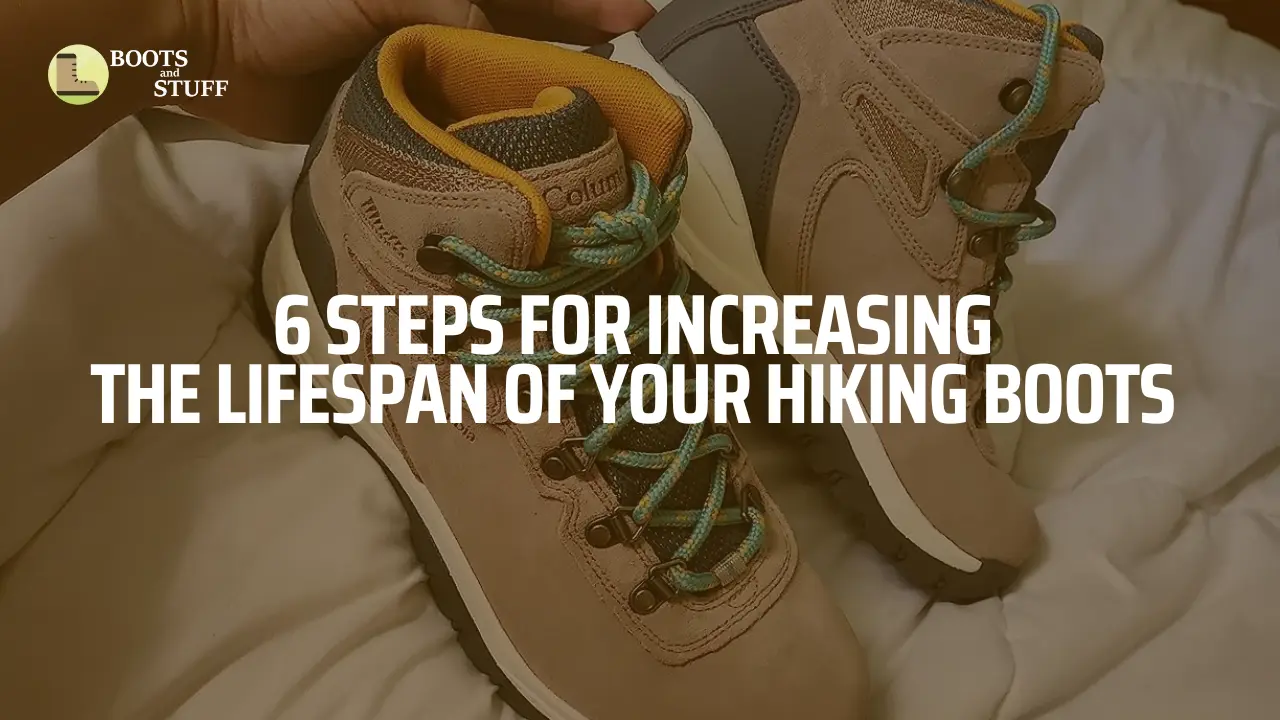
As with anything else, the better you care for it, the longer it will endure. This is also true for hiking footwear. I’ve listed some boot care tips below. There is no doubt that if you care for your shoes properly by following these guidelines, they will last you a long time. I conferred with a few professionals while writing this article. I also adopted the makers’ recommendations. As a result, this manual for correct care has become unrivaled. Let’s take a look at how to care for your hiking boots.
Step 1: Store Your Hiking Boots in a Temperature-Controlled Room
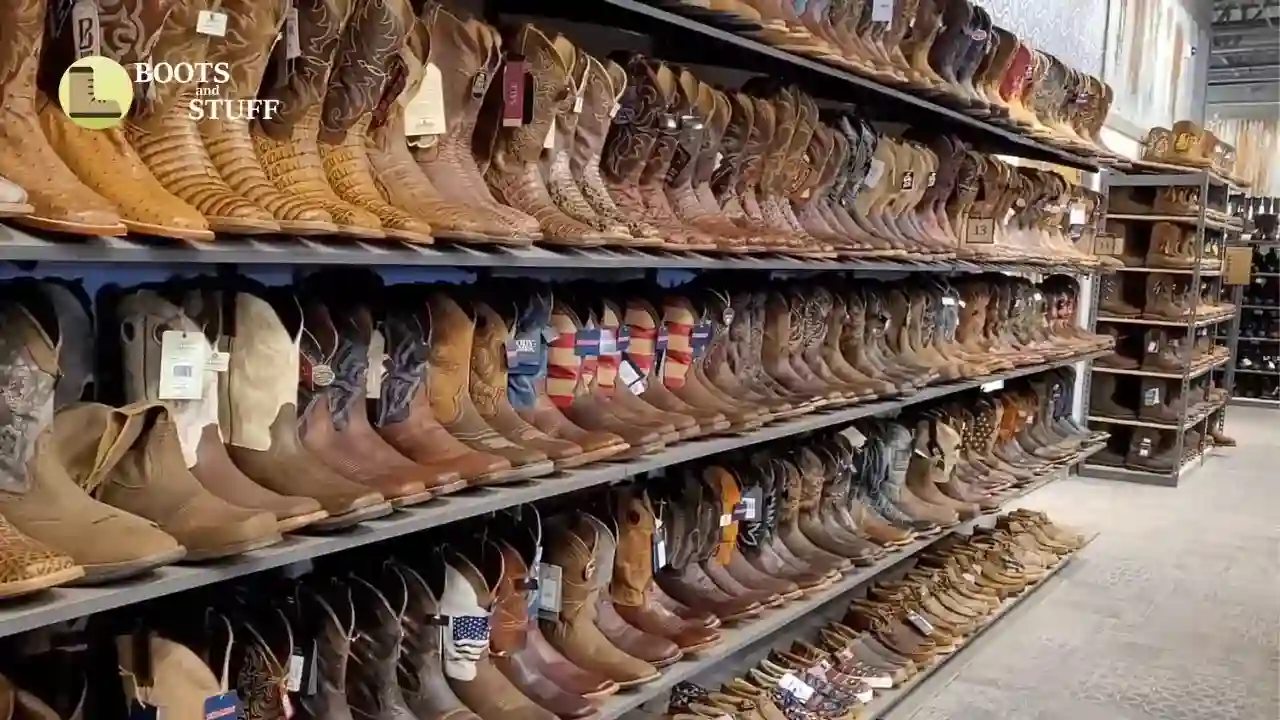
If you want to protect your handbags, clothes, or favorite pair of shoes, you must have a temperature-controlled place. Temperature-controlled storage is required for hiking footwear because they are mostly made with pigskin leather or mesh fabrics, and these things need a cool and dry environment.
Too much heat with a higher degree of humidity can damage the outside of your boot. It mainly ages the leather very quickly. For insoles and cushioning, a cool and dry environment is recommended by the manufacturers of these shoes.
Step 2: Apply Leather and Waterproofing Treatments to Your Shoes

You can use waterproof spray if you have a pair of leather boots. Waterproof sprays come in aerosol form, and you can directly apply them to your pair. You can also use waterproofing wax; it may take some time to use, but to save time, waterproof sprays are the best options.
After every hike, to prevent your boots from eroding, you can use Tarrago’s nano-protective spray. This is a Spanish brand renowned in the market for its best quality. Leather boots have pores; they are mostly like our skin, and through the pores, water can come and damage the entire part. Fluorocarbon polymer seals the pores and saves your boots from getting damaged by water. Here is a step-by-step guide on waterproofing hiking boots you can check out right now.
Step 3: Always Maintain Your Boot’s Cleanliness by Removing Dirt and Debris
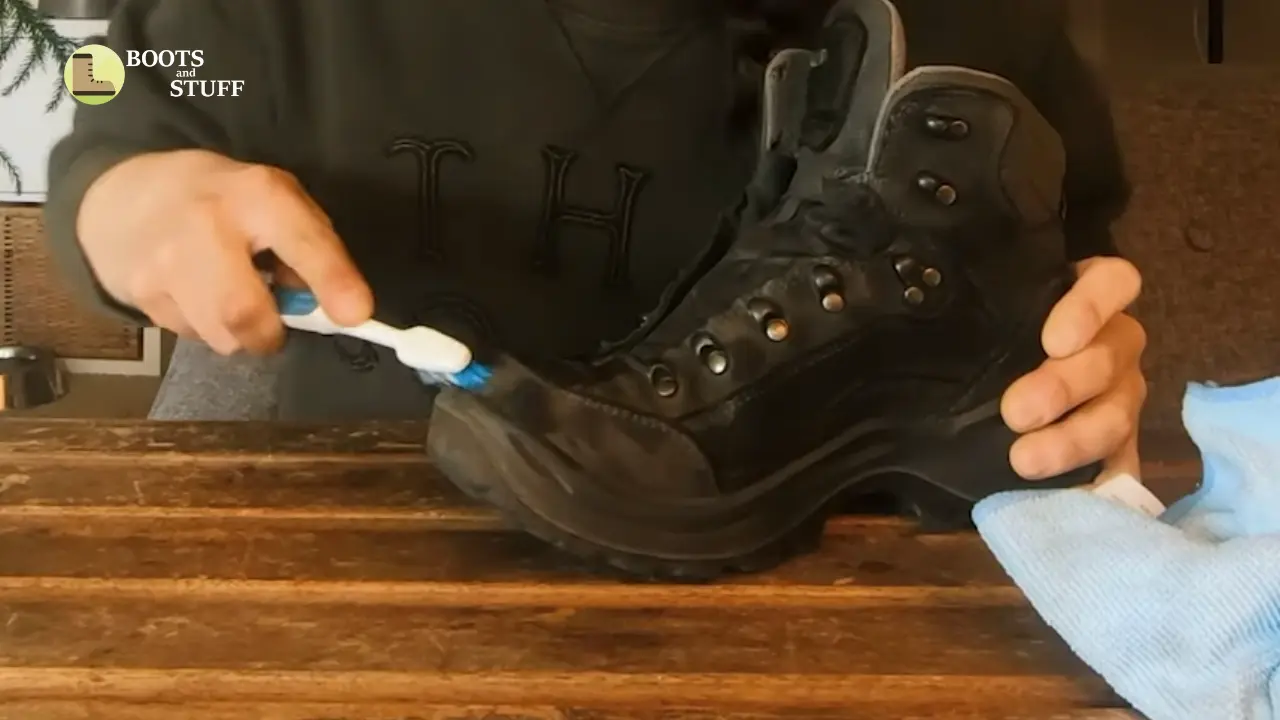
Always clean your boots before and after every hike. When cleaning, be sure to pay attention to the construction and materials of your boots. Because the cleaning method for leather boots and the cleaning method for shoes made of nylon fabric are not the same, since the two substances are different, the cleaning procedures are also different.
A stiff brush can be used to clean dust from nylon shoes. Be careful when cleaning the inside of your boots. And for the easiest and most reliable method, you can read our hiking boot cleaning guide.
Step 4: Remove The Moisture from Your Boot Insoles Regularly

Your shoe insoles will get wet after cleaning; be sure to dry them at room temperature. Avoid direct sunlight. You can dry your shoes in a cool, shaded, and well-ventilated place. You can stuff old newspaper or tissue paper inside the shoe to absorb excess moisture from the inside. This will dry your shoes faster.
Step 5: Replace Your Insoles If They Start to Lose Support
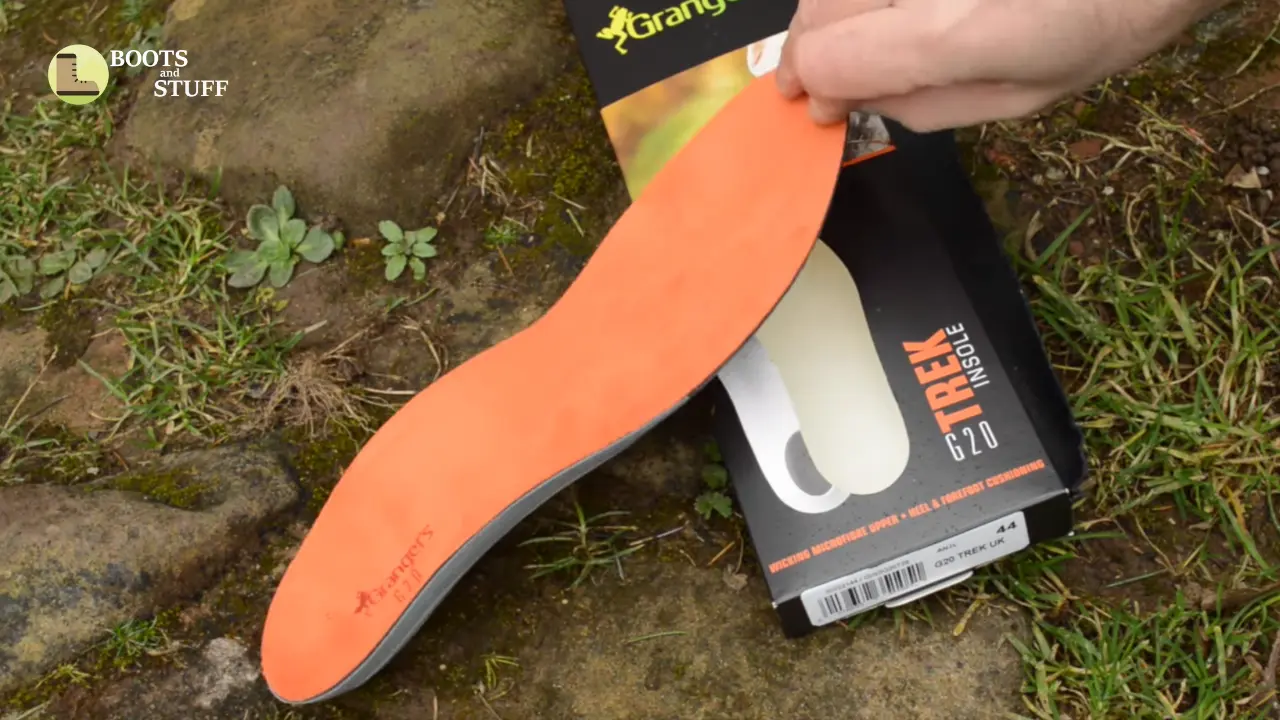
Over time, you will notice that the insoles inside your shoes are gradually getting quite tight. And stiff insoles can cause plantar fasciitis, weak ankles, blisters, and alignment problems in your feet. It is quite difficult to restore the softness of a hard insole. And so, when you experience insole problems on your feet, do not hesitate to remove the old insoles and replace them with new ones.
Step 6: Eliminate Minor Issues
Small bumps on your shoes are possible. Your shoe inserts may not be correctly fitted. It is also possible that the glue has opened slightly. There’s no reason for worry that you’ll have to throw away the whole pair of shoes because of a minor issue like this. All of these problems can be resolved using shoe glue. It is best to deal with problems when they are little.
Frequently Asked Questions:
Here I will answer some of the FAQs about the lifetime of hiking boots.
How Long Do Salomon Hiking Boots Last?
Salomon is a renowned brand in the footwear industry. Salomon hiking boots last for more than five to six years if you use them on average. You may get 800 to 1000 miles from Salomon hiking boots.
How Long Do Merrell Hiking Boots Last?
People reported that Merrel hiking boots, specifically the Merrell Moab 3, typically have a lifetime of over 5 years. Merrel Moab 3 will give you 700–1000 miles. So, for durability, you can definitely rely on this renowned hiking boot brand.
How Long Should Scarpa Boots Last?
Scarpa will last for at least 6 years if you purchase their Zodiac Plus GTX model. After hiking for 500+ miles, you’ll not notice any wearing signs. The average mileage of the Scarpa Zodiac Plus GTX is 1200+. This boot is a bit pricey than the Salomon and Merrel, but it will give you the best value for your money.
How Long Do Vasque Boots Last?
Hiking boots from the brand Vasque may last for over 3 years, and for mileage, you can expect 400–500 miles. Users and hikers reported that this style ‘St. Elias Fg Gtx’ has worn out after traveling 400+ miles in rocky terrain.
How Long Does Oboz Last?
Hiking boots from Oboz may last for over 3 years; specifically, this model, the Bridger Mid B-Dry, will typically last for at least 4 years. You can expect 700+ miles of rough hiking from this boot model.
Wrap Up
I have been thinking of writing this blog for a long time. If you want to buy very good-quality hiking boots, then you have to spend a lot. Because good-quality boots are durable, they also cost more. But how long will your hiking boots actually last? It is very important to know the lifespan of any type of boot. Because if you know this information, you can easily make a very good decision while purchasing.
You can follow my exclusive boot care guide to extend the lifespan of your hiking boots. Also, don’t forget to check out the related blogs. Below, I have included some information in the FAQ section. I tried to make the blog informative enough, so don’t forget to share the blog with your friends.


